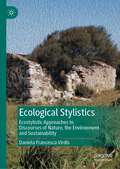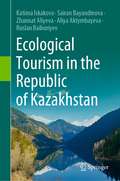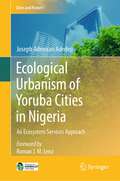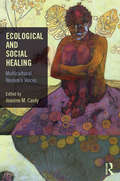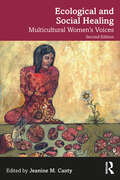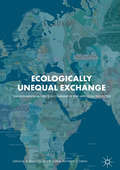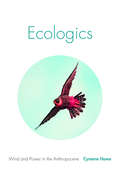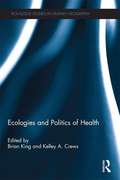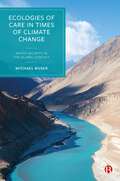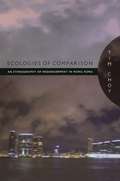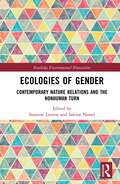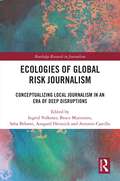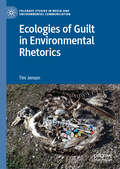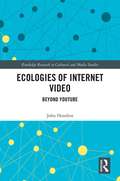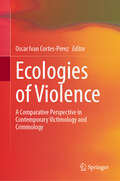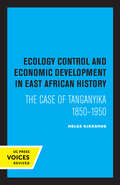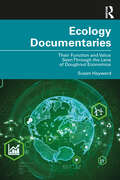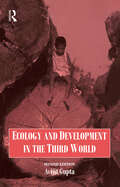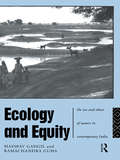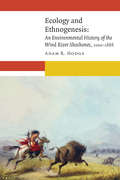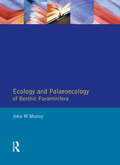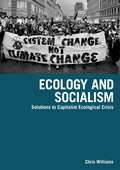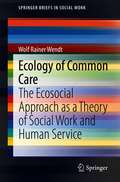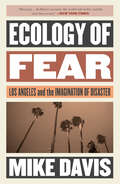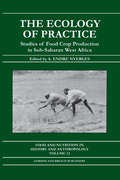- Table View
- List View
Ecological Stylistics: Ecostylistic Approaches to Discourses of Nature, the Environment and Sustainability
by Daniela Francesca VirdisThis book reflects the cutting edge in ecostylistic approaches to nature, the environment and sustainability as represented in contemporary non-literary discourse. Firstly, the book presents the ecolinguistic and stylistic terms and theories applied in this ecostylistic analysis (ecosophy, beneficial, ambivalent and destructive discourses; and foregrounding, point of view, metaphor), and reviews the most recent literature in the field of ecostylistics. Secondly, the book examines the occurrences of five marker words (nature, environment, ecosystem, ecology, sustainability) on the websites of five environmental organisations and agencies (Forestry England, Greenpeace International, National Park Service, Navdanya International, World Wide Fund for Nature). The main research purpose of this study is to identify beneficial discourses in the environet and to investigate the beneficial ecostylistic strategies utilised to produce them. Above all, this book reminds us humans that we do not stand apart from nature: we are a part of it. The book will be of interest to scholars of stylistics, ecolinguistics and ecocriticism, as well as scholars of discourse analysis, environmental communication and environmental humanities.
Ecological Tourism in the Republic of Kazakhstan
by Sairan Bayandinova Katima Iskakova Zhannat Aliyeva Aliya Aktymbayeva Ruslan BaiburiyevThis book analyses the theoretical and methodological foundations of ecotourism and geotourism and examines the essence, content, factors, and models of ecotourism development. The authors conducted research to assess the tourist and recreational potential of ecotourism in Kazakhstan. The study analyses the current state and describes the problems of the long-term development of ecotourism. Besides, the authors also show the role of specially protected natural areas in ecotourism development, including a list of organizations that can create tourist products in the environmental direction. This book also defines the primary conditions necessary for ecotourism in protected natural and rural areas. The resulting cartographic material visualizes the geospatial potential of the regions of Kazakhstan, aiming a more targeted expenditure of financial resources allocated to tourism development. Thus, the presented book is relevant from a practical perspective to scientists and researchers and is of value to business structures and stakeholders.
Ecological Urbanism of Yoruba Cities in Nigeria: An Ecosystem Services Approach (Cities and Nature)
by Joseph Adeniran AdedejiThis book offers in-depth ethnographic analyses of key informants’ interviews on the ecological urbanism and ecosystem services (ES) of selected green infrastructure (GI) in Yoruba cities of Ile-Ife, Ibadan, Osogbo, Lagos, Abeokuta, Akure, Ondo, among others in Southwest Nigeria. It examines the Indigenous Knowledge System (IKS) demonstrated for wellbeing through home gardens by this largest ethno-linguistic group in Nigeria. This is in addition to the ES of Osun Grove UNESCO World Heritage Site, Osogbo; Biological Garden and Park, Akure; Lekki Conservation Centre, Lagos; Adekunle Fajuyi Park, Ado-Ekiti; Muri Okunola Park, Lagos; and some institutional GI including University of Ibadan Botanical Gardens, Ibadan; Federal University of Agriculture Abeokuta Botanical Garden, Abeokuta; and University of Lagos Lagoon Front Resort, Lagos, Nigeria. The study draws on theoretical praxis of Western biophilic ideologies, spirit ontologies of the Global South, and largely, Millennium Ecosystem Assessment (2005) to examine eco-cultural green spaces, home gardens, and English-types of parks and gardens as archetypes of GI in Yoruba traditional urbanism, colonial and post-colonial city planning. The book provides methods of achieving a form of modernized traditionalism as means of translating the IKS into design strategies for eco-cultural cities. The strategies are framework, model, and ethnographic design algorithms that are syntheses of the lived experiences of the key informants.
Ecological and Social Healing: Multicultural Women's Voices
by Jeanine M. CantyThis book is an edited collection of essays by fourteen multicultural women (including a few Anglo women) who are doing work that crosses the boundaries of ecological and social healing. The women are prominent academics, writers and leaders spanning Native American, Indigenous, Asian, African, Latina, Jewish and Multiracial backgrounds. The contributors express a myriad of ways that the relationship between the ecological and social have brought new understanding to their experiences and work in the world. Moreover by working with these edges of awareness, they are identifying new forms of teaching, leading, healing and positive change. Ecological and Social Healing is rooted in these ideas and speaks to an "edge awareness or consciousness." In essence this speaks to the power of integrating multiple and often conflicting views and the transformations that result. As women working across the boundaries of the ecological and social, we have powerful experiences that are creating new forms of healing. This book is rooted in academic theory as well as personal and professional experience, and highlights emerging models and insights. It will appeal to those working, teaching and learning in the fields of social justice, environmental issues, women's studies, spirituality, transformative/environmental/sustainability leadership, and interdisciplinary/intersectionality studies.
Ecological and Social Healing: Multicultural Women's Voices
by Jeanine M. CantyA compendium of diverse women and nonbinary femmes, the second, expanded edition of this book highlights the contributors’ journeys with straddling social and ecological issues through both their professional and personal paths and reveals how straddling these edges has surfaced new learning, models, and practices for collective healing. The contributors span multiple generations and positionalities and are prominent academics, writers, teachers, artists, leaders, and healers. Ecological and Social Healing is rooted in the power of integrating multiple and often conflicting views and the transformations that result.This book is rooted in academic theory as well as personal and professional experience and highlights emerging models and insights. It will appeal to those working, teaching, and learning in the fields of social justice, environmental issues, women and gender studies, animal rights, ecopsychology, spirituality, transformative studies, transdisciplinarity, leadership, and interdisciplinary/intersectionality studies, as well as anyone straddling the boundaries of gender, race, ecology, and the crises of our times and are looking for new ways of being.
Ecologically Unequal Exchange: Environmental Injustice in Comparative and Historical Perspective
by Harry F. Dahms R. Scott Frey Paul K. GellertAt a time of societal urgency surrounding ecological crises from depleted fisheries to mineral extraction and potential pathways towards environmental and ecological justice, this book re-examines ecologically unequal exchange (EUE) from a historical and comparative perspective. The theory of ecologically unequal exchange posits that core or northern consumption and capital accumulation is based on peripheral or southern environmental degradation and extraction. In other words, structures of social and environmental inequality between the Global North and Global South are founded in the extraction of materials from, as well as displacement of waste to, the South. This volume represents a set of tightly interlinked papers with the aim to assess ecologically unequal exchange and to move it forward. Chapters are organised into three main sections: theoretical foundations and critical reflections on ecologically unequal exchange; empirical research on mining, deforestation, fisheries, and the like; and strategies for responding to the adverse consequences associated with unequal ecological exchange. Scholars as well as advanced undergraduate and graduate students will benefit from the spirited re-evaluation and extension of ecologically unequal exchange theory, research, and praxis.
Ecologics: Wind and Power in the Anthropocene
by Cymene HoweBetween 2009 and 2013 Cymene Howe and Dominic Boyer conducted fieldwork in Mexico's Isthmus of Tehuantepec to examine the political, social, and ecological dimensions of moving from fossil fuels to wind power. Their work manifested itself as a new ethnographic form: the duograph—a combination of two single-authored books that draw on shared fieldsites, archives, and encounters that can be productively read together, yet can also stand alone in their analytic ambitions. In her volume, Ecologics, Howe narrates how an antidote to the Anthropocene became both failure and success. Tracking the development of what would have been Latin America's largest wind park, Howe documents indigenous people's resistance to the project and the political and corporate climate that derailed its renewable energy potential. Using feminist and more-than-human theories, Howe demonstrates how the dynamics of energy and environment cannot be captured without understanding how human aspirations for energy articulate with nonhuman beings, technomaterial objects, and the geophysical forces that are at the heart of wind and power.
Ecologies and Politics of Health: Ecologies And Politics Of Health (Routledge Studies in Human Geography)
by Brian King Kelley A. CrewsHuman health exists at the interface of environment and society. Decades of work by researchers, practitioners, and policy-makers has shown that health is shaped by a myriad of factors, including the biophysical environment, climate, political economy, gender, social networks, culture, and infrastructure. Yet while there is emerging interest within the natural and social sciences on the social and ecological dimensions of human disease and health, there have been few studies that address them in an integrated manner. Ecologies and Politics of Health brings together contributions from the natural and social sciences to examine three key themes: the ecological dimensions of health and vulnerability, the socio-political dimensions of human health, and the intersections between the ecological and social dimensions of health. The thirteen case study chapters collectively present results from Africa, Asia, Latin America, the United States, Australia, and global cities. Section one interrogates the utility of several theoretical frameworks and conventions for understanding health within complex social and ecological systems. Section two concentrates upon empirically grounded and quantitative work that collectively redefines health in a more expansive way that extends beyond the absence of disease. Section three examines the role of the state and management interventions through historically rich approaches centering on both disease- and non-disease-related examples from Latin America, Eastern Africa, and the United States. Finally, Section four highlights how health vulnerabilities are differentially constructed with concomitant impacts for disease management and policy interventions. This timely volume advances knowledge on health-environment interactions, disease vulnerabilities, global development, and political ecology. It offers theoretical and methodological contributions which will be a valuable resource for researchers and practitioners in geography, public health, biology, anthropology, sociology, and ecology.
Ecologies of Care in Times of Climate Change: Water Security in the Global Context
by Michael BuserAvailable open access digitally under CC BY NC ND licence. This book investigates and analyses places in Europe, North America and Asia that are facing the immense challenges associated with climate change adaptation. Presenting real-world cases in the contexts of coastal change, drinking water and the cryosphere, Michael Buser shows how the concept of care can be applied to water security and climate adaptation. Exploring the everyday and often hidden ways in which water security is accomplished, the book demonstrates the pervasiveness and power of care to contribute to flourishing lives and communities in times of climate change.
Ecologies of Comparison: An Ethnography of Endangerment in Hong Kong
by Timothy ChoyA rich ethnography of ecopolitics in Hong Kong in the late 1990s, as the region shifted to Chinese sovereignty, Ecologies of Comparison describes how ecological concepts of uniqueness and scale resonated among environmentalists, including those seeking to preserve a species of white dolphin, to protect an aging fishing village from redevelopment, and to legitimize air quality as an object of political and medical concern. During his research, Tim Choy became increasingly interested in the power of the notion of specificity. While documenting the expert and lay production of Hong Kong's biological, cultural, and political specificities, he began comparing the logics and narrative forms that made different types of specificity--such as species, culture, locality, and state autonomy--possible and meaningful. He came to understand these logics and forms as "ecologies of comparison," conceptual practices through which an event or form of life comes to matter in environmentalist and other political terms. Choy's ethnography is about environmentalism, Hong Kong, and the ways that we think about environmentalism in Hong Kong and other places. It is also about how politics, freedom, culture, expertise, and other concepts figure in comparison-based knowledge practices.
Ecologies of Gender: Contemporary Nature Relations and the Nonhuman Turn (Routledge Environmental Humanities)
by Susanne LettowEcologies of Gender: Contemporary Nature Relations and the Nonhuman Turn examines the role of gender in recent debates about the nonhuman turn in the humanities, and critically explores the implications for a contemporary theory of gender and nature relations. The interdisciplinary contributions in this volume each provides theoretical reflections based on an analysis of specific naturecultural processes. They reveal how "ecologies of gender" are constructed through aesthetic, epistemological, political, technological and economic practices that shape multispecies and material interrelations as well as spatial and temporal orderings. The volume includes contributions from cultural anthropology, cultural studies, film studies, literary studies, media studies, philosophy and theatre studies. The essays are organized around four key dimensions of an "ecological" understanding of gender: "creatures", "materials", "spaces" and "temporalities". The overall aim of the volume Ecologies of Gender: Contemporary Nature Relations and the Nonhuman Turn is to explore the potentialities and limitations of the nonhuman turn for a critical analysis and theory of ecologies of gender, and thereby make an original contribution to both the environmental humanities and gender studies. This book will be of great interest to scholars and students from the interdisciplinary field of the environmental humanities and environmental studies more broadly, as well as from gender studies and cultural theory.
Ecologies of Global Risk Journalism: Conceptualizing Local Journalism in an Era of Deep Disruptions (Routledge Research in Journalism)
by Ingrid Volkmer Saba Bebawi Bruce Mutsvairo Ansgard Heinrich Antonio CastilloThis volume investigates the practice and challenges of journalism addressing globalized risk from various world regions.With chapters written by members of the Global Risk Journalism Hub, an international research network of leading scholars from the Global North and Global South, this collection brings together international journalism researchers from a wide range of theoretical and methodological backgrounds to uncover key issues of "global risk journalism" within their regional contexts. Using the climate crisis and the COVID-19 pandemic as a point of departure, this book explores the effect of digital platforms on news production, how the reporting of these transnational emergencies affects the misinformation ecosystem, the power relations between global and local news sources and the ethics of conducting research in the face of globalized crises.This truly international and comparative volume will interest researchers and students of global and local journalism, risk journalism, journalism practice, media and communication studies, intercultural communication, political science and sociology.
Ecologies of Guilt in Environmental Rhetorics (Palgrave Studies in Media and Environmental Communication)
by Tim JensenEnvironmental rhetorics have expanded awareness of mass extinction, climate change, and pervasive pollution, yet failed to generate collective action that adequately addresses such pressing matters. This book contends that the anemic response to ecological upheaval is due, in part, to an inability to navigate novel forms of environmental guilt. Combining affect theory with rhetorical analysis to examine a range of texts and media, Ecologies of Guilt in Environmental Rhetorics positions guilt as a keystone emotion for contemporary environmental communication, and explores how it is provoked, perpetuated, and framed through everyday discourse. In revealing the need for emotional literacies that productively engage our complicity in global ecological harm, the book looks to a future where guilt—and its symbiotic relationships with anger, shame, and grief—is shaped in tune with the ecologies that sustain us.
Ecologies of Internet Video: Beyond YouTube (Routledge Research in Cultural and Media Studies)
by John HondrosThis book explores the complex, dynamic, and contested webs of relationships in which three different groups of video makers found themselves when distributing their work on the Internet. It draws upon both the Deleuzian notion of "assemblage" and Actor-Network Theory, which together provide a rich conceptual framework for characterizing and analysing these webs. The groups examined are a UK video activist project, a community of film and television fans originating in the US, and an association of US community television producers. Rather than taking YouTube as its point of departure, this book centres on the groups themselves, contextualizing their contemporary distribution practices within their pre-Internet histories. It then follows the groups as they drew upon various Internet technologies beyond YouTube to create their often-complex video distribution assemblages, a process that entangled them in these webs of relationships. Through the analysis of detailed ethnographic fieldwork conducted across a period of several years, this book demonstrates that while the groups found some success in achieving their various goals as video makers, their situations were often problematic and their agency limited, with their practices contested by both human and technological actors within their distribution assemblages.
Ecologies of Violence: A Comparative Perspective in Contemporary Victimology and Criminology
by Oscar Ivan Cortes-PerezThis volume offers an in-depth exploration of the complex and evolving manifestations of violence through a comparative and contextual lens. Addressing a wide range of violent behaviors—from intimate partner violence and human trafficking to acid attacks and child victimization—this book presents an interdisciplinary approach that blends criminology, victimology, and psychosocial insights. By focusing on the interaction between victims and offenders within diverse socio-cultural and institutional contexts, it highlights the multifaceted nature of violence as a central construct in both criminological and victimological studies. The chapters integrate innovative theoretical perspectives and evidence-based practices drawn from international research, primarily from Spain, Mexico, and Australia. The text emphasizes the need for tailored interventions and prevention strategies that account for the unique characteristics and relational dynamics between victims and offenders across different environments. Topics include emerging forms of violence, such as chemical violence and femi-disappearances, as well as established issues like family violence, bullying, and the cumulative harm of childhood trauma. By advancing beyond conventional crime and deviance paradigms, this book redefines the study of violence, offering fresh epistemological reflections on its role in shaping victimization and criminal behavior. With its focus on qualitative and comparative methodologies, this volume provides a vital resource for researchers, practitioners, and policymakers seeking to understand and address violence in its many forms. This book is essential reading for scholars in criminology, victimology, and social sciences, as well as professionals working in violence prevention, justice, and human rights sectors.
Ecology Control and Economic Development in East African History: The Case of Tanganyika 1850–1950 (Eastern African Studies)
by Helge KjekshusThis title is part of UC Press's Voices Revived program, which commemorates University of California Press’s mission to seek out and cultivate the brightest minds and give them voice, reach, and impact. Drawing on a backlist dating to 1893, Voices Revived makes high-quality, peer-reviewed scholarship accessible once again using print-on-demand technology. This title was originally published in 1977.
Ecology Documentaries: Their Function and Value Seen Through the Lens of Doughnut Economics
by Susan HaywardThis companion piece to Susan Hayward’s Film Ecology focuses on ecology documentaries produced in the first 20 years of the new millennium (2000–19). Using Kate Raworth’s regenerative economic theoretical model as set out in Doughnut Economics, this book examines 57 films emanating from Europe and the 4 areas of concern they raise about energy production, pollution and waste management, agribusiness, disrupted ecosystems and the migratory f low. These ecology documentaries make explicit the damage done to our planet thanks to growth capitalism and neoliberal globalisation. But they also provide the evidence that solutions to this planetary abuse exist. The book demonstrates how these documentaries reveal the process of humankind’s planetary plundering and explores the structuring of the eco-doc as a new generic type in the domain of documentary practice. Using Raworth’s model allows us to measure the tentacular extent of the planetary harm growth economics induces and, too, by way of contrast, perceive how regenerative economics can work to redress this harm, heal the Earth and make it a safe place for humanity. This book is ideal for film studies scholars and students, including those teaching or studying film practice, documentary film, European cinema and environmental studies, as well as economists interested in regenerative economic models. It also has general appeal to all who are concerned about some of the major causes of planetary degradation and its impact on humanity and Earth.
Ecology and Development in the Third World (Routledge Introductions To Development Ser.)
by Avijit Gupta A. GuptaThis comprehensive second edition provides an up-to-date introduction to the nature of ecological degradation in a world of dramatic environmental change.
Ecology and Equity: The Use and Abuse of Nature in Contemporary India (Oxford India Paperbacks Ser.)
by Ramachandra Guha Madhav GadgilEnvironmental destruction is seen a matter of worldwide concern but as a Third World problem. Ecology and Equity explores the most ecologically complex country in the world. India's peoples range from technocrats to hunter-gathers and its environments from dense forest to wasteland. The bookanalyses the use and abuse of nature on the sub-continent to reveal the interconnections of social and environmental conflict on the global scale. The authors argue that the root of this conflict is competition within different social groups and between different economic interests for natural resources. Radical both in its critique of the causes of crisis in India and in its proposals for ecological reform, Ecology and Equity is essential reading for all concerned for the Third World's in the world.
Ecology and Ethnogenesis: An Environmental History of the Wind River Shoshones, 1000–1868 (New Visions in Native American and Indigenous Studies)
by Adam R. HodgeIn Ecology and Ethnogenesis Adam R. Hodge argues that the Eastern Shoshone tribe, now located on the Wind River Reservation in Wyoming, underwent a process of ethnogenesis through cultural attachment to its physical environment that proved integral to its survival and existence. He explores the intersection of environmental, indigenous, and gender history to illuminate the historic roots of the Eastern Shoshone bands that inhabited the intermountain West during the nineteenth century. Hodge presents an impressive longue durée narrative of Eastern Shoshone history from roughly 1000 CE to 1868, analyzing the major developments that influenced Shoshone culture and identity. Geographically spanning the Great Basin, Rocky Mountain, Columbia Plateau, and Great Plains regions, Ecology and Ethnogenesis engages environmental history to explore the synergistic relationship between the subsistence methods of indigenous people and the lands that they inhabited prior to the reservation era. In examining that history, Hodge treats Shoshones, other Native peoples, and Euroamericans as agents who, through their use of the environment, were major components of much broader ecosystems. The story of the Eastern Shoshones over eight hundred years is an epic story of ecological transformation, human agency, and cultural adaptation.Ecology and Ethnogenesis is a major contribution to environmental history, ethnohistory, and Native American history. It explores Eastern Shoshone ethnogenesis based on interdisciplinary research in history, archaeology, anthropology, and the natural sciences in devoting more attention to the dynamic and often traumatic history of “precontact” Native America and to how the deeper past profoundly influenced the “postcontact” era.
Ecology and Palaeoecology of Benthic Foraminifera
by John W. MurrayThis is an important and authoritative review of foraminiferal ecology, the first for over a decade. Professor Murray relates ecological data on living forms of foraminifera to the palaeoecology of fossil species, and defines in detail areas of global distribution.
Ecology and Socialism
by Chris WilliamsAround the world, consciousness of the threat to our environment is growing. The majority of solutions on offer, from using efficient light bulbs to biking to work, focus on individual lifestyle changes, yet the scale of the crisis requires far deeper adjustments. Ecology and Socialism argues that time still remains to save humanity and the planet, but only by building social movements for environmental justice that can demand qualitative changes in our economy, workplaces, and infrastructure.Chris Williams is a longtime environmental activist, professor of physics and chemistry at Pace University, and chair of the science department at Packer Collegiate Institute. He lives in New York City.
Ecology of Common Care: The Ecosocial Approach as a Theory of Social Work and Human Service (SpringerBriefs in Social Work)
by Wolf Rainer WendtThis book offers an ecological foundation for social work and for care provision in general. It presents the ecosocial approach according to its origins, distinguishing it from other theoretical social work approaches and applying it to various areas of care for welfare. The ecological anchoring of social welfare and common care is an emerging topic in political, organisational, and person-related development of human services and social work. In an era of crisis, this anchoring is an essential contribution to the study of sustainable social provision. The book embeds the dispositions about it in the ecology of the protection and securing of common life. Ecology of Common Care: The Ecosocial Approach as a Theory of Social Work and Human Service is an essential text that should engage the academic community of educators and researchers in social work and other human services professions, as well as students in bachelor's and master's programmes in these professions.
Ecology of Fear: Los Angeles and the Imagination of Disaster
by Mike DavisA witty and engrossing look at Los Angeles' urban ecology and the city's place in America's cultural fantasiesEarthquakes. Wildfires. Floods. Drought. Tornadoes. Snakes in the sea, mountain lions, and a plague of bees. In this controversial tour de force of scholarship, unsparing vision, and inspired writing, Mike Davis, the author of City of Quartz, revisits Los Angeles as a Book of the Apocalypse theme park. By brilliantly juxtaposing L.A.'s fragile natural ecology with its disastrous environmental and social history, he compellingly shows a city deliberately put in harm's way by land developers, builders, and politicians, even as the incalculable toll of inevitable future catastrophe continues to accumulate.Counterpointing L.A.'s central role in America's fantasy life--the city has been destroyed no less than 138 times in novels and films since 1909--with its wanton denial of its own real history, Davis creates a revelatory kaleidoscope of American fact, imagery, and sensibility. Drawing upon a vast array of sources, Ecology of Fear meticulously captures the nation's violent malaise and desperate social unease at the millennial end of "the American century." With savagely entertaining wit and compassionate rage, this book conducts a devastating reconnaissance of our all-too-likely urban future.
Ecology of Practice
by NyergesFirst Published in 1998. Routledge is an imprint of Taylor & Francis, an informa company.
